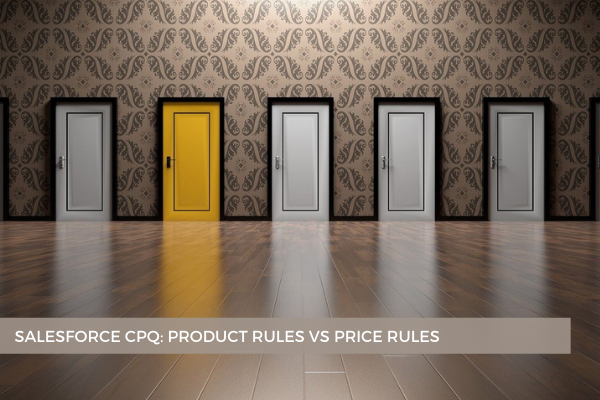
30
OctHave you ever wondered which functionality to use in Salesforce CPQ? Product Rules or Price Rules? They might look similar, but there are some obvious differences between them, besides the fact that Product Rules use Error Conditions, and Price Rules use Price Conditions. Let's take a deep dive and see what they are.
As we mentioned above, the overall structure of these rules is the same. So we have:
- General Properties on the Rule Record,
- Conditions (Both support Advanced Condition Logic. It can be applied when the user selects the Custom Value for the Condition Met field on a Rule which uses a combination of AND and OR logic for the evaluation of three or more conditions), and
- Actions.
That is, there is the rule record which contains the general properties, then there are certain conditions that need to be met in order for the actions to fire.
Speaking of their scope, Product Rules can target either the Product Configuration page or the Quote Line Editor. The two options are:
- Product, meaning that the rule will run during product configuration, and
- Quote, meaning that the rule will run on the Quote Line Editor.
Similarly, Price Rules can run on either the Configurator or the Quote Line Editor’s Calculator. The two alternatives are:
- Quote, that is the rule will apply to the quote, visible on the Quote Line Editor, and
- Product, meaning that the rule will apply to the bundle, visible during configuration.
Actually, it's in the actions and use cases where you'll find the major differences between these two types of rules. Product Rules are used to enforce business logic, help automate feedback to sales reps about product selections and they also accelerate the quoting process, and ensure that the users are quoting the optimal products. They are extremely useful when you have certain product dependencies and compatibilities that need to be taken into consideration during the sales and quoting process. That being said, it should be mentioned that there are 4 types of Product Rules depending on what they do, on their the actual actions:
- Validation Rules ensure a technically valid solution by evaluating the quote lines or product options and making sure that the conditions are being met. When the conditions are not met, an error message is displayed and the users can't continue until the situation is fixed. So, they act as a hard stop.
- Alert Rules are a soft stop as compared to the Validation Rules' hard stop. You would use this rule for example to notify users that approval is required in order to discourage them from discounting irresponsibly while in the Quote Line Editor. They also display a message, but it's more as a suggestion because the user can proceed without meeting the specified business requirements.
- Selection Rules can add, remove, show, hide, enable, or disable or perform some combination of these actions on product options within a bundle or they can add a product to a quote. This rule can be a great way to leverage Guided Selling in order to guide your reps to the appropriate or most desired options by automatically selecting the right products.
- Filter Rules are used in bundles to pull in product options from the product catalog using a filter rule. This is often referred to as creating a dynamic bundle.
Price Rules, on the other hand, can be considered as a way to make field updates within the calculation that will affect the pricing. Basically what they do is inject a value into the quote or a quote line field. This value can be a static value, it can be a calculated value like a formula field or it can be a summary variable which is a roll-up in Salesforce CPQ. Truth be told, Price Rules don't target just pricing. They can be used instead of Workflow Rules, Process Builder, and Triggers to update field values. You can use them to mark quotes that need to be approved or mark quotes that should be included in certain reports. Or you can use them to set discounts or quantities.
Thus, on a very high level, bear in mind that Product Rules make sure that users put together the right products and bundles (they validate, alert, select, and filter), while the Price Rules automate price calculations and update quote and quote line fields (they send values to the target fields).
Comments (0)